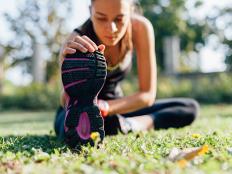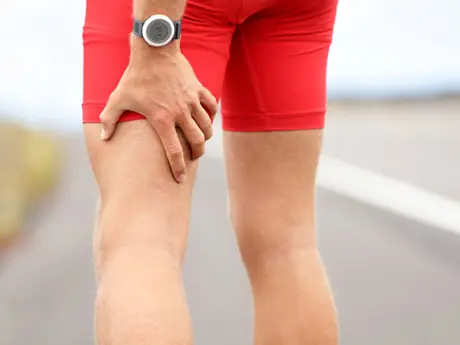Switch positions and seats, if possible, every 30 minutes during the day. Varied posture remains the best posture, according to Duke, so cross your left leg, then a half-hour later, cross your right leg; sit on top of your ankle, sit straight, and even slouch.
Try sitting on a stability ball—it challenges your abdominal muscles and allows you to rock your pelvis, which lubricates your joints. Switch between a chair and stability ball, stand, and take short walk breaks if you work in an office. "One position for various amounts of time is disastrous for the spine," says Duke.
Whether you run in the morning soon after rising, or in the afternoon/evening after sitting all day at work, a proper warm-up also helps prevent injury.
More: How to Detect a Running Injury
Warm-up and Stretches to Prevent Injury
After years and years of treating patients for the majority of the same injuries, and recognizing patterns such as not warming up and/or stretching properly, Duke developed an app, called W.E. Run, that demonstrates warm-up and stretching exercises.
"You need to warm up the hip in circular patterns, and you need to warm up the spine in rotary movements," says Duke. "You need to wake up the outer buttock muscles, called the glute medius, in order to keep your pelvis stable when you go for a run. Those are the essentials."
The best injury-preventing warm-up for runners includes exercises that support the spine, get you locomotive, lubricate the joints, "and break up the intra-articular adhesions that get stuck in the joint and prevent it from fluid mobility," says Duke. Your hip socket is a great example—you need to warm up your hips so they can move as freely as possible to respond to slips, quick changes in stride and uneven terrain.
More: 4 Dynamic Warm-up Exercises for Runners
Duke's warm-up takes two minutes to complete; do 10 or so reps of each exercise and move to the next. Start each exercise in a standing position.
- Diagonal leg swings: Hold on to the wall or a chair for balance. Extend your left leg straight to the side and swing it from side to side in front of your body. Repeat on right leg.
- Hip gyros: Hold on to the wall or a chair for balance. Raise the left leg and, keeping the knee bent, circle the leg inward for 10, then outward for 10. Repeat on the other leg.
- Side lunges: Start with feet together. Lunge to the left, keeping your right leg straight and extended and your left knee bent. Let your weight shift a bit back to keep pressure off your knee. Repeat, and then complete on right leg. "This wakes up the glute medius, which helps keep your pelvis level while running," says Duke.
- 2
- of
- 3
About the Author

Get ACTIVE on the Go


Couch to 5K®
The best way to get new runners off the couch and across the finish line of their first 5K.
Available for iOS | Android







Discuss This Article